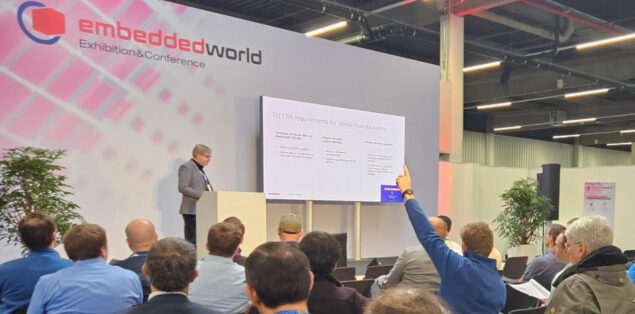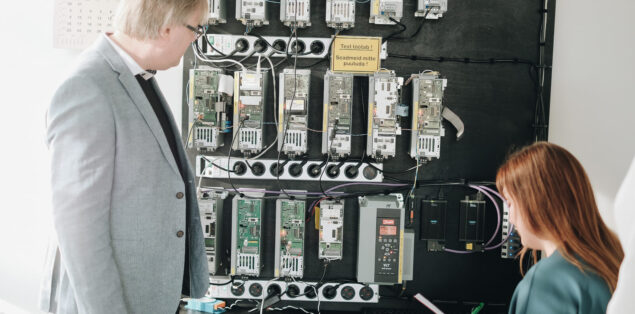Natural Selection in the Manufacturing Industry

The most critical factor separating a manufacturer from Industry 4.0 is not any issue inherent to the shop floor. It is stagnation and the unwillingness to change.
– Kadri-Liis Kusmin
IoT 4.0 and digitization of factories
Industry 4.0 is the new buzzword of the manufacturing industry, a sequent wave of distinct industrial advancements that takes the digitization of factories even further. By making use of today’s novel technologies including high-speed network communications, big-data and cloud computing, today’s factories will evolve into smart lights-out factories, where intelligent machines take over the more repetitive tasks and human workers can focus on the more innovative challenges. The clear course of Industry 4.0 has not been defined yet and its success or failure greatly depends on actions taken today.

We at Proekspert / simFactory believe Industry 4.0 will be what we make of it, and thus we put our effort into building a better future with our industry partners. We have visited many manufacturing plants, and even though each of them has its own nuances, the bulk of issues overlap and most can be solved through the application of ICT. Thus, the most critical factor separating a manufacturer from Industry 4.0 is not any issue inherent to the shop floor. It is stagnation and the unwillingness to change.
Today’s factories / future smart factories
Our industry partners are determined to use ICT to its full potential, and working together we have developed solutions to integrate shop-floor machinery to visualize real-time data, reduce the time operators spend on manual bureaucracy, and promote the competencies of the future workforce. Regarding the readiness for Industry 4.0, today’s factories can roughly be categorized into two groups: process-driven factories and impulse-driven factories.
Process-driven factories have maximally optimized their processes, everything is planned, and work usually goes according to plan. The main issues derive from the factors that cannot be planned: machinery incidents, unexpected maintenance, or issues with the workforce. The problem is that the company wants to grow but the processes cannot be optimized further. This means they need to find other improvement areas, for example digitization. However, moving from a process-driven mindset to a data-driven mindset can be very hard, especially if there are no major issues. The factory works just fine, especially compared to less-advanced competitors, so they don’t really have an incentive to look for more advanced production methods.
Impulse-driven factories also rely on processes, but they are not optimized, which causes some struggle. When orders come in, it is not easy to estimate production capacity and provide dates for clients. Production processes aren’t very well planned because the company lacks objective data. This results in non-transparent production that can often generate a culture of blame: if something happens (or even worse – does not happen), the first action is to look for the responsible party, instead of improving the process. These factories often understand that they’re struggling and thus they are more motivated to find help from new developments in IT.
Data-driven factories
Either of these factories could make investments into digitization and the widespread application of ICT to become a data-driven factory. In a data-driven factory, production systems are integrated throughout the value chain, enabling the factory to make use of big data and cloud computing. From this data, patterns emerge, that assist in decision making and estimation. Advanced analytics, predictive maintenance, and data-driven simulations help avoid machinery failures, and assist in planning maintenance and shop floor changes. Progressive cyber-physical systems control and monitor the processes, and manufacturing is based on facts instead of being reliant on micro-level planning. To control these processes, the human workforce is supplied with state-of-the-art ICT tools that make use of advancements in augmented reality and intelligent robotics. This frees the human workforce from more repetitive tasks and allows them to focus on more challenging ones, including R&D and innovation. Naturally, work life will improve: employees have greater autonomy in making decisions, they are more engaged in product and process development, and are free to regulate their own workload. The work can be done over a network, balancing work and private lives.

Transparent real-time date brings the customers closer, both virtually and physically. Thanks to virtual design processes and self-service portals, individual customers are able to supply their own designs and provide stronger input for the general production process. Having largely automated the physical production processes of the factory, the company has chosen to bring the factory physically closer to the customer to shorten the logistics chain and delivery time. Hence, the application of the Industry 4.0 concept improves the lives of each human group in the manufacturing ecosystem: business people, shop floor workers, and customers.
Rudimentary factories
If manufacturers refuse to evolve, they may soon find themselves in the interchangeable and easily replaceable role of mere suppliers. They’re unable to compete on anything other than price, whereas their competitors have moved on to novel, service-based business models which attract customers with new possibilities like rapid prototyping and mass customization. While rivals attract human workers with challenging and innovative tasks, a flexible workplace, targeted development options, and state-of-the-art tools, competing in the labor market will get ever more difficult and may result in massive recruitment challenges and talent shortage. Proprietary data and communication protocols hinder the use of novel technologies by limiting compatibility of products from other companies or regions, and this increases integration costs.
These are only a few example cases that could result from inactivity or responding to changes too late. Additional challenges include safety and security, legal issues, concerns regarding intellectual property, and standardization. None of these issues are insoluble, but they need to be considered well in advance and in cooperation with all of the stakeholders.
Success through symbiosis
Even if manufacturers cannot yet visualize themselves as futuristic data-driven factories, there are no arguments against digitization and the application of ICT. It is not obligatory to transform the whole factory, but instead existing issues can be solved with the future in mind. Although the concept of Industry 4.0 is not yet widespread, there is great potential that it will penetrate and improve many aspects of human life and today’s manufacturing. To achieve this, all stakeholders need to work together. After all, there is no path set for Industry 4.0 – it will be what we make of it.
Connect with us!
We’re open to cooperation with electronics manufacturers who face similar challenges. Contact us by signing up for the demo on our website to receive more information about simFactory.
About Proekspert
Proekspert is a skilled software development company with over 30 years of experience. We have encountered many diverse approaches to equipment, software engineering, and cybersecurity. Our expertise covers embedded software, device-cloud integrations, technician apps, and portals.









